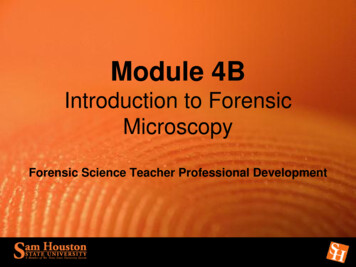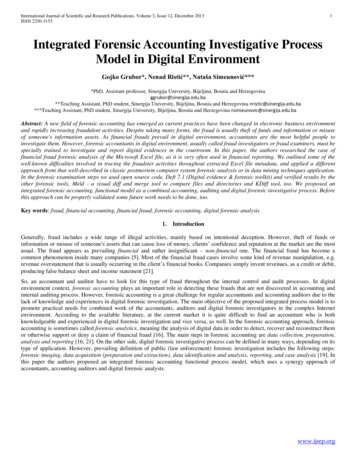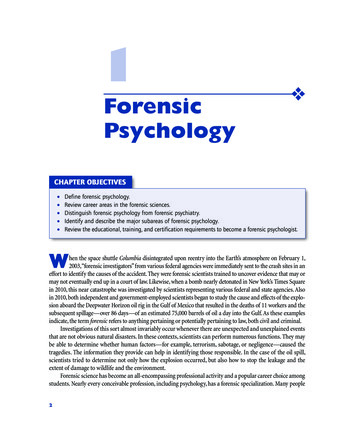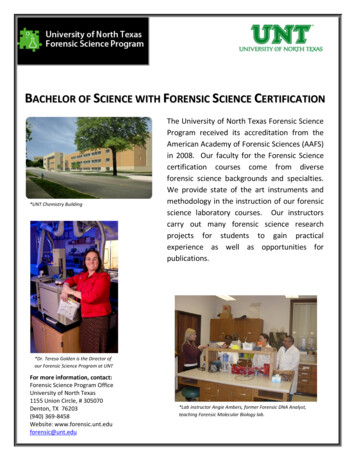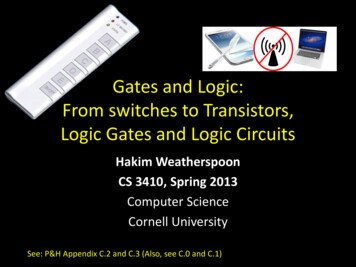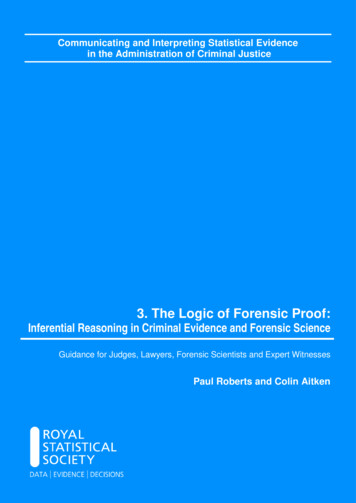
Transcription
Communicating and Interpreting Statistical Evidencein the Administration of Criminal Justice3. The Logic of Forensic Proof:Inferential Reasoning in Criminal Evidence and Forensic ScienceGuidance for Judges, Lawyers, Forensic Scientists and Expert WitnessesPaul Roberts and Colin Aitken
PRACTITIONER GUIDE NO 3The Logic of Forensic Proof: Inferential Reasoning inCriminal Evidence and Forensic ScienceGuidance for Judges, Lawyers, Forensic Scientists and Expert WitnessesByPaul RobertsProfessor of Criminal Jurisprudence,University of NottinghamandColin AitkenProfessor of Forensic Statistics,University of EdinburghPrepared under the auspices of theRoyal Statistical Society’s Working Group on Statistics and the Law(Chairman: Colin Aitken)
Contents0IntroductionMembership of the RSS Working Group on Statistics and the Law2111The Inferential Logic of Judicial Evidence and Proof121.11.41.121.151.171.19Inferential reasoning and rational adjudicationCommon sense inference and common law evidenceInferential tasks in criminal adjudicationUnpacking and unpicking common sense inferenceNarrative – what’s the story?Analytical models of inferential reasoning1215222425272Propositions and Logical Inferences302.12.52.92.112.192.252.31Varieties of propositionFormulating propositions (with the utmost care)Ultimate and penultimate probandaThree forms of logical inferenceMapping ‘simple’ inferencesSymbolic notationSummary303439414750583Neo-Wigmorean Analysis613.13.43.63.133.153.35Wigmore’s original insightThe neo-WigmoreansWigmorean methodThe practical utility of chartingCharting – in seven easy stepsSummary and critical appraisal6164667476974Bayesian Networks1034.14.34.64.104.174.26Why Bayes Nets?Bayesianism and English lawBayesian networks as forensic decision aidsTerminology and constitutive elementsTrace evidence logic – Bayes nets in contemporary forensic practiceExtended illustration – Bayesian network analysis of shoe-mark evidence1031051091141211315Summary – Appreciating the Logic of Forensic Proof1445.15.55.75.95.115.145.16Scope and objectives of the GuidePropositionsForensic logic and probandaSymbolic representationWigmore chartsBayesian networksLogic, in the end and in the beginning 144146147148149151153Bibliography1541
Introduction to Communicating and Interpreting Statistical Evidencein the Administration of Criminal Justice0.1Context, Motivation and ObjectivesStatistical evidence and probabilistic reasoning today play an important and expandingrole in criminal investigations, prosecutions and trials, not least in relation to forensicscientific evidence (including DNA) produced by expert witnesses. It is vital thateverybody involved in criminal adjudication is able to comprehend and deal withprobability and statistics appropriately. There is a long history and ample recentexperience of misunderstandings relating to statistical information and probabilitieswhich have contributed towards serious miscarriages of justice.0.2Criminal adjudication in the UK’s legal jurisdictions is strongly wedded to the principleof lay fact-finding by juries and magistrates employing their ordinary common sensereasoning. Notwithstanding the unquestionable merits of lay involvement in criminaltrials, it cannot be assumed that jurors or lay magistrates will have been equipped by theirgeneral education to cope with the forensic demands of statistics or probabilisticreasoning. This predictable deficit underscores the responsibilities of judges and lawyers,within the broader framework of adversarial litigation, to ensure that statistical evidenceand probabilities are presented to fact-finders in as clear and comprehensible a fashion aspossible. Yet legal professionals’ grasp of statistics and probability may in reality be littlebetter than the average juror’s.Perhaps somewhat more surprisingly, even forensic scientists and expert witnesses,whose evidence is typically the immediate source of statistics and probabilities presentedin court, may also lack familiarity with relevant terminology, concepts and methods.Expert witnesses must satisfy the threshold legal test of competency before being allowedto testify or submit an expert report in legal proceedings. 1 However, it does not followfrom the fact that the witness is a properly qualified expert in say, fingerprinting or1R v Atkins [2010] 1 Cr App R 8, [2009] EWCA Crim 1876; R v Stockwell (1993) 97 Cr App R260, CA; R v Silverlock [1894] 2 QB 766, CCR.2
ballistics or paediatric medicine, that the witness also has expert – or even rudimentary –knowledge of statistics and probability. Indeed, some of the most notorious recentmiscarriages of justice involving statistical evidence have exposed errors by experts.There is, in short, no group of professionals working today in the criminal courts that canafford to be complacent about their existing levels of knowledge and competence in usingstatistical methods and probabilistic reasoning.0.3.Well-informed observers have for many decades been arguing the case for making basictraining in probability and statistics an integral component of legal education (e.g. Kaye,1984). But little tangible progress has been made. It is sometimes claimed that lawyersand the public at large fear anything connected with probability, statistics or mathematicsin general, but irrational fears are plainly no excuse for ignorance in matters of such greatpractical importance. More likely, busy practitioners lack the time and opportunities tofill in persistent gaps in their professional training. Others may be unaware of their lackof knowledge, or believe that they understand enough already, but do so only imperfectly(‘a little learning is a dang’rous thing’2).0.4.If a broad programme of education for lawyers and other forensic practitioners is needed,what is required and how should it be delivered? It would surely be misguided and awasted effort to attempt to turn every lawyer, judge and expert witness (let alone everyjuror) into a professor of statistics. Rather, the objective should be to equip forensicpractitioners to become responsible producers and discerning consumers of statisticsand confident exponents of elementary probabilistic reasoning. Every participant incriminal proceedings should be able to grasp at least enough to perform their respectiveallotted roles effectively and to discharge their professional responsibilities in theinterests of justice.For the few legal cases demanding advanced statistical expertise, appropriately qualifiedstatisticians can be instructed as expert witnesses in the normal way. For the rest, lawyers2Alexander Pope, An Essay on Criticism (1711).3
need to understand enough to be able to question the use made of statistics orprobabilities and to probe the strengths and expose any weaknesses in the evidencepresented to the court; judges need to understand enough to direct jurors clearly andeffectively on the statistical or probabilistic aspects of the case; and expert witnesses needto understand enough to be able to satisfy themselves that the content and quality of theirevidence is commensurate with their professional status and, no less importantly, with anexpert witness’s duties to the court and to justice.30.5There are doubtless many ways in which these pressing educational needs might be met,possibly through a package of measures and programmes. Of course, design andregulation of professional education are primarily matters to be determined by therelevant professional bodies and regulatory authorities. However, in specialist mattersrequiring expertise beyond the traditional legal curriculum it would seem sensible forauthoritative practitioner guidance to form a central plank of any proposed educationalpackage. This would ideally be developed in conjunction with, if not directly under theauspices of, the relevant professional bodies and education providers.The US Federal Judicial Center’s Reference Manual on Scientific Evidence (ThirdEdition, 2011) provides a valuable and instructive template.4 Written with the needs of alegal (primarily, judicial) audience in mind, it covers a range of related topics, including:data collection, data presentation, base rates, comparisons, inference, association andcausation, multiple regression, survey research, epidemiology and DNA evidence. Thereis currently no remotely comparable UK publication specifically addressing statisticalevidence and probabilistic reasoning in criminal proceedings in England and Wales,Scotland and Northern Ireland.3R v B(T) [2006] 2 Cr App R 3, [2006] EWCA Crim 417, [176]. And see Rule 33.2 of theCriminal Procedure Rules: ‘Expert’s duty to the court’.4The recently-revised third edition of the Reference Manual is published jointly by the NationalAcademy of Sciences and the Federal Judicial Center, and can be accessed rl l /public/home.nsf/inavgeneral?openpage&url r /public/home.nsf/pages/1448.4
0.6In association with the Royal Statistical Society (RSS) and with the support of theNuffield Foundation, we aim to fill this apparent gap in UK forensic practitionerguidance by producing a themed set of four Practitioner Guides on different aspects ofstatistical evidence and probabilistic reasoning, to assist judges, lawyers, forensicscientists and other expert witnesses in coping with the demands of modern criminallitigation. The Guides are being written by a multidisciplinary team principallycomprising a statistician (Aitken), an academic lawyer (Roberts), and two forensicscientists (Jackson and Puch-Solis). They are produced under the auspices of the RSS’sWorking Group on Statistics and the Law, whose membership includes – or has includedsince 2008 – representatives from the judiciary, the English Bar, the Scottish Faculty ofAdvocates, the Crown Prosecution Service, the National Policing Improvement Agency(NPIA),5 the Scottish Police Services Authority and the Forensic Science Service,6 aswell as academic lawyers, statisticians and forensic scientists.0.7Using the Four Practitioner Guides – Notes, Caveats and DisclaimersThe four Practitioner Guides have been produced over a five-year period, with the finaltwo Guides being published early in 2014. They are intended, when completed, to form acoherent package, but each Guide is also designed to function as a stand-alonepublication addressing a specific topic or set of related issues in detail. Some of thematerial restates elementary principles and general background that every criminal justicepractitioner really ought to know. More specialist sections of the Guides might be dippedinto for reference as and when occasion demands. We hope that this modular format willmeet the practical needs of judges, lawyers and forensic scientists for a handy work ofreference that can be consulted, possibly repeatedly, whenever particular statistical orprobability-related issues arise during the course of criminal litigation.The NPIA seat on our working group is currently vacant, following NPIA’s abolition andreplacement by the National Crime Agency pursuant to the Crime and Courts Act 2013.6The Forensic Science Service ceased casework operations and was effectively closed down inMarch 2012: see House of Commons Science and Technology Committee, Forensic Science,Second Report of Session 2013-14, HC 610 (TSO 2013); & The Forensic Science Service.Seventh Report of Session 2010–12, HC 855 (TSO, 2011).55
0.8Guide No 1 was published in December 2010 as Colin Aitken, Paul Roberts andGraham Jackson, Fundamentals of Probability and Statistical Evidence in CriminalProceedings (RSS, 2010). This first Guide provides a general introduction to the role ofprobability and statistics in criminal proceedings, a kind of vade mecum for the perplexedforensic traveller; or possibly, ‘Everything you ever wanted to know about probability incriminal litigation but were too afraid to ask’. It explains basic terminology and concepts,illustrates various forensic applications of probability, and draws attention to commonreasoning errors (‘traps for the unwary’).Guide No 2 was published in March 2012 as Roberto Puch-Solis, Paul Roberts, SusanPope, and Colin Aitken, Assessing the Probative Value of DNA Evidence (RSS, 2012).Building on the general introduction to statistical evidence and probabilistic reasoning incriminal proceedings provided by our the first practitioner guide, Guide No 2 explores theprobabilistic foundations of DNA profiling evidence and considers how to evaluate itsprobative value in criminal trials. It explains the basic procedures for producing a DNAprofile and the methods for calculating its probability in simple and more complex cases.This Guide also briefly describes different types of DNA profiling, including ‘lowtemplate’ LTDNA, and discusses some issues surrounding the presentation andinterpretation of DNA evidence in criminal trials.Both published Guides are available free to download from the RSS website:www.rss.org.uk/statsandlaw.0.9The present Guide is the third in this series of interdisciplinary practitioner guidancemanuals. Its topic is the inferential logic of judicial evidence and proof. Havingelucidated the simple, but powerful, basic principles of inferential logic, it goes on toexplain how inferential reasoning can usefully be encapsulated and summarised ingraphical models, some of which are capable of incorporating cumulative conditionalprobabilities. Formal methods for calculating the probability of chains of relatedinferences are gaining wider recognition in contemporary forensic science practice. Othermodels promote more rigorous evidential analysis and improve the construction of6
forensic arguments without explicit quantification. The fourth and final Guide in thequartet, which is being published concurrently with the present Guide, addressesprinciples of forensic case assessment and interpretation, with particular regard to theway in which forensic science evidence is presented and evaluated in criminal trials.Each Guide focuses on topics of major practical importance in the administration ofcriminal justice, all of which merit sustained investigation in their own right. Theindividual Guides are free-standing publications that can be read as a narrative expositionor dipped into as works of reference. Taken together, the series of four Guides is intendedto illuminate the general themes, questions, concepts and issues affecting thecommunication and interpretation of statistical evidence and probabilistic reasoning inthe administration of criminal justice.0.10We should flag up at the outset certain methodological challenges confronting thisambitious undertaking, not least because it is unlikely that we have overcome them allentirely satisfactorily.First, we have attempted to address multiple professional audiences. Insofar as there is acore of knowledge, skills and resources pertaining to statistical evidence and probabilisticreasoning which is equally relevant for trial judges, lawyers, forensic scientists and otherexpert witnesses involved in criminal proceedings, it makes sense to pitch the discussionat this generic level. All participants in the process would benefit from improvedunderstanding of other professional groups’ perspectives, assumptions, concerns andobjectives. For example, lawyers might adapt and enhance the ways in which theyinstruct experts and adduce their evidence in court by gaining insight into forensicscientists’ thinking about probability and statistics; whilst forensic scientists, for theirpart, may become more proficient as expert witnesses by gaining a better appreciation oflawyers’ assumptions and expectations of expert evidence, in particular regarding theextent and implications of its probabilistic underpinnings.7
We recognise, nonetheless, that certain parts of the following discussion may be ofgreater interest and practical utility to some criminal justice professionals than to others.Our hope is that judges, lawyers and forensic scientists will be able to extrapolate fromthe common core to their particular interests and professional concerns. We have stoppedwell short of presuming to specify formal criteria of legal admissibility or attempting toformulate boilerplate instructions for judges to direct juries in criminal trials. It is not forus to make detailed recommendations on the law and practice of criminal procedure.0.11The following exposition is also generic in a second, related sense. This Guide isintended to be useful, and to be widely used, in all of the United Kingdom’s legaljurisdictions. It goes without saying that the laws of probability, unlike the laws of theland, are valid irrespective of geography. It would be artificial and sometimes misleadingwhen describing criminal litigation to avoid any reference whatsoever to legal preceptsand doctrines, and we have not hesitated to mention legal rules where the contextdemands it. However, we have endeavoured to keep such references fairly general andnon-technical – for example, by referring in gross to ‘the hearsay prohibition’ whilstskating over jurisdictionally-specific doctrinal variations with no particular bearing onprobability or statistics. Likewise, references to points of comparative law – such as Scotslaw’s distinctive court structure or verdict rules – will be few and brief. Readers shouldnot expect to find a primer on criminal procedure in the following pages.0.12The preparation of this Guide has benefited enormously from the generous (unpaid) inputof fellow members of the RSS’s Working Group on Statistics and the Law and from theguidance of our distinguished international advisory panel. We are also very grateful toAlex Biedermann and Franco Taroni for their generous substantive, pictorial andbibliographical contributions to the treatment of Bayesian networks presented in Part 4.HHJ John Phillips and Sheriff John Horsburgh QC kindly read drafts and providedhelpful advice and suggestions, at unfeasibly short notice. Academic colleagues,including Alex Biedermann (again), David Lagnado (on behalf of Norman Fenton’sresearch group at QMUL) and William Twining, were very generous in offeringextensive critical feedback and suggestions for improvements (some of which we are still8
mulling over) on a preliminary draft. Whilst we gratefully acknowledge our intellectualdebts to this extraordinarily well-qualified group of supporters and friendly critics, thetime-honoured academic disclaimer must be invoked with particular emphasis on thisoccasion: ultimate responsibility for the contents of this Guide rests solely andexclusively with the named authors, and none of our Working Group colleagues or otheradvisers and commentators should be assumed to endorse all, or any particular part, ofthe text.The vital contribution of the Nuffield Foundation,7 without whose enthusiasm andgenerous financial support this project could never have been brought to fruition, isgratefully acknowledged. However, the views expressed in this Guide are the authors’.They are not necessarily endorsed by the Nuffield Foundation.0.13We welcome further constructive feedback on all four published Guides. We are keen tohear about practitioners’ experiences of using them and to receive suggestions foramendments, improvements or other material that could usefully be incorporated intorevised editions.All correspondence should be addressed to:Royal Statistical SocietyChairman of the Working Group on Statistics and the Law12 Errol StreetLondonEC1Y 8LX7The Nuffield Foundation is an endowed charitable trust that aims to improve social well-beingin the widest sense. It funds research and innovation in education and social policy and alsoworks to build capacity in education, science and social science research. Further iesandactivitiesisavailableat www.nuffieldfoundation.org.9
Alternatively, responses may be sent by email to c.g.g.aitken@ed.ac.uk, with the subjectheading ‘Practitioner Guide No. [1, 2, 3and/or 4, as appropriate]’.Our intention is to revise and reissue all four Guides as a consolidated publication, takingaccount of further comments and correspondence, during 2015. The latest date forsubmitting feedback for this purpose will be 1 September 2014.Paul RobertsMarch 2014Colin Aitken10
Membership of the Royal Statistical Society’sWorking Group on Statistics and the LawWorking GroupColin Aitken, University of Edinburgh, ChairmanIain Artis, Faculty of AdvocatesGraham Cooke, Kings Bench Chambers, BournemouthMark Fenhalls, Criminal Bar AssociationNina Fisher, Law Society of England and WalesAndrew Garratt, Royal Statistical Society, Secretary to the Working GroupPeter Gill, University of OsloHHJ Anna Guggenheim QCGraham Jackson, Abertay University and the Forensic Science SocietyJohn Logue, Crown OfficeTim Moloney, Criminal Bar AssociationTom Nelson, Scottish Police Services AuthorityNiamh Nic Daeid, University of StrathclydeRoberto Puch-Solis, LGC ForensicsMike Redmayne, LSEPaul Roberts, University of NottinghamJim Smith, Royal Statistical Society and University of WarwickKaren Squibb-Williams, Crown Prosecution ServiceInternational Advisory PanelJoe Cecil, Federal Judicial Center, Washington DCStephen Fienberg, Carnegie-Mellon UniversityJames Franklin, University of New South Wales, SydneyJoseph Gastwirth, George Washington UniversityJonathan J. Koehler, Arizona State UniversityRichard Lempert, University of MichiganNell Sedransk, National Institute of Statistical Science, Research Triangle Park, NCFranco Taroni, Institute of Police Science, University of LausannePeter Tillers, Cardozo Law School, New York11
1. The Inferential Logic of Judicial Evidence and Proof1.1Inferential Reasoning and Rational AdjudicationCriminal adjudication aspires to be rational. We want verdicts in criminal cases toexpress truthful judgments about criminal wrongdoing and blameworthy conduct, andthis can be achieved only if those who are found guilty by process of law are in factguilty of the crimes of which they are convicted. As Rule 1.1(a) of the CriminalProcedure Rules spells out, dealing with criminal cases justly first and foremost entailsthat the guilty should be convicted and the innocent acquitted. This is a generalaspiration. It plainly does not follow that these outcomes are valued equally, or that weshould favour maximising correct decisions if this might imply that more innocent peoplewould have to be wrongly convicted in order to ensure that fewer guilty people wereerroneously acquitted. Traditionally, English law asserts just the opposite, that it is betterto acquit ten guilty defendants than to convict one innocent (see Roberts and Zuckerman2010: 240-65)Evidence is the key to rational adjudication. The prevailing assumption is that people aremore likely to be guilty if the evidence of their guilt is strong, and correspondingly lesslikely to be guilty if the evidence implicating them in a crime is weak or non-existent. Afurther assumption is that we can reliably identify ‘strong’ evidence and differentiate itfrom ‘weak’ evidence. Such questions about the quality and strength of evidence – itsweight or ‘probative value’ - already presuppose a commitment to taking evidenceseriously. At a general structural level, evidence-based adjudication might be contrastedwith forms of adjudication based on divine revelation, rituals or chance. For example, wemight settle contested criminal cases by throwing dice or – adapting the punishment ofdecimation applied to deserting Roman legions - by convicting every tenth defendant andacquitting the rest. Proceeding in either fashion would reflect a different conception ofthe rationality of adjudication to the one subscribed to today by all modern systems ofcriminal trial. From the perspective of evidence-based verdicts, we might simply brandthese alternative conceptions irrational.12
Evidence is linked to proof through inferential reasoning. Evidence is constituted byinformation or data. The ultimate question for the fact-finder in criminal adjudication iswhether the available information/data-set is sufficient to warrant a particular conclusion,e.g. whether the evidence is sufficiently probative to make the jury sure that the accusedis guilty. The conclusion that the accused is guilty is a conclusion inferred from theevidence, an inferential conclusion. Inferential reasoning (typically in combination withother reasoning strategies and shortcuts) is integral to the process through which the jury‘gets to guilty’, or to any other decisional destination the jury deems warranted by theevidence (e.g. that the evidence is not sufficient to prove guilt beyond reasonable doubt,so that the accused must be acquitted in accordance with the legal burden and standard ofproof).1.2Inferential reasoning increases one’s stock of information, knowledge and beliefs. Itsometimes proceeds deductively, where particular premisses dictate a given inferentialconclusion. So if we know that all men are mortal, and we also know that Socrates is aman, we can deduce – infer by deduction – that Socrates is mortal. We began with twopropositions which a deductive process of inferential reasoning enabled us to turn intothree. Our knowledge has increased by inference.More commonly, inferential reasoning proceeds by induction. Rather than starting withpremisses known or assumed to be certain (like Socrates’ mortality), inferences aregenerally erected upon information believed true only as a matter of probability andgeneralisations that are true only for the most part. For example, a person found inpossession of recently stolen goods is probably the thief, but he might not be. He could bea handler of stolen goods, or even a good Samaritan intent on returning stolen property toits rightful owner. Human reasoning is characteristically reasoning in conditions ofuncertainty. Thus, at the outset of the trial the jury does not know whether the accused isguilty or innocent. It must draw inferences from the evidence presented in the trial, andarrive at its inferential conclusions, as a matter of probability.13
Not all reasoning is inferential and not all gains in knowledge are attributable toinferences. One does not infer that 2 2 4; this result is simply true by stipulation andfollows from the correct application of mathematical axioms. Nor does one infer that abachelor is unmarried. This is an analytic (linguistic) truth. The marital status of thebachelor is already contained in the meaning of the word.The extent to which perceptual knowledge is inferential is open to debate. Do I see adoor, or do I see a large vertical slab of wood with a brass handle filling a hole in thewall, from which I infer that I am looking at a door? Probably the best analyticaldescription of human perception depends on context and purpose. At all events,perceptual data clearly do often motivate inferential reasoning, as when I hear a car tootits horn and infer that you have arrived to pick me up from the station, or see you frownand infer that you are angry, or feel the heat of the radiator and infer that the boiler isswitched on, etc.1.3Inferential reasoning is a pervasive and prosaic feature of human existence. People drawinferences all the time in their daily lives, normally without giving any conscious thoughtto the nature of the inferential process itself. Inferential reasoning is largely ‘commonsense’. However, the fact that inferential reasoning is commonplace should not beconfused with the notion that the process itself is simple or easy to understand. Humanbeings are, somehow, able to perform inferential tasks of staggering complexity and witha level of proficiency that computer software engineers and experiments in artificialintelligence have thus far failed even to begin to approximate.Juries (and other fact-finders) in criminal cases arrive at their verdicts by applying theirordinary, familiar techniques of common sense inferential reasoning. Indeed, layinvolvement in criminal adjudication is justified on the explicit basis that disputedallegations of criminal wrongdoing should be resolved through the application ofordinary common sense (inferential) reasoning, rather than by specialist juridicalreasoning procedures or other forms of technical expertise. As Lord Justice Rosereiterated in R v Adams, ‘[j]urors evaluate evidence and reach a conclusion not by means14
of a formula, mathematical or otherwise, but by the joint application of their individualcommon sense and knowledge of the world to the evidence before them’.81.4Common Sense Inference and Common Law EvidenceTraditional common law evidentiary principles and doctrines are built on the foundationsof common sense inference. Or, since common sense inferences are pervasive but seldomsystematically examined or evaluated, it would be more accurate to say that common lawevidence is built on a set of assumptions about common sense inferential reasoning.For example, confession evidence is treated as highly probative because we assume thatpeople would not make admissions against their own interests unless they were speakingthe truth. Likewise, we assume that first-hand information is more reliable than secondor third-hand gossip, and consequently direct oral testimony is preferred to hearsay.9 Itdoes not follow that confessions should always be admitted in evidence or that hearsayshould always be excluded. The common law has long recognised that the reliability ofconfessions is predicated on the further assumption that admissions were freely made,hence voluntariness is a precondition of the admissibility of the accused’s extra-judicialconfessions.10 Conversely, hearsay may still be sufficiently significant or presumptivelyreliable to warrant its admission at trial, but its probative value will typically bediscounted to reflect the common sense generalisation that hearsay is inferior to firsthand-informat
6 The Forensic Science Service ceased casework operations and was effectively closed down in March 2012: see House of Commons Science and Technology Committee, Forensic Science, Second Report of Session 2013-14, HC 610 (TSO 2013); & The Forensic Science Service. Seventh Report of Session 2010-12, HC 855 (TSO, 2011).






